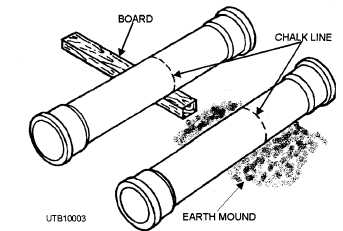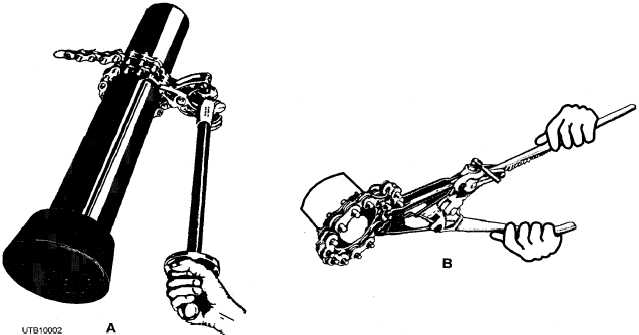cast-iron soil pipe is 5 feet, the overall length is 5 feet 3 inches.
The most common measurement of cast-iron soil pipe, for a shorter length than 5 feet, is the overall measurement. When making this measurement for 4- inch pipe, you should take the desired length of pipe for the installation and add 3 inches to it for the bell.
CUTTING. - Before joining cast-iron pipe, you often have to cut the pipe to provide the desired length. Cast-iron soil pipe can be cut with an abrasive cutter, a band saw, a hydraulic manual snap or ratchet cutter (fig. 3-3, views A and B), or a hammer and chisel. The hammer and chisel method is slow and used only when other cutting tools are not available. Here is a step-by- step procedure for cutting with a hammer and chisel.

Figure 3-4. - Supporting soil pipe for cutting.
Mark or score the pipe with a triangular file or wrap your belt around the pipe and mark the cut line with soap stone.
Lay the pipe over a board or mound of earth at the point to be cut to support the pipe (fig. 3-4) and allow it to turn easily.
Score the pipe with a cold chisel (not too sharp). Move the chisel a little at a time along the mark, tapping lightly with a hammer until the pipe is evenly scored all around.
Continue to turn the pipe and strike the chisel with increasingly heavier blows until the pipe breaks on the line evenly.
Another means of cutting a short piece, 1 or 2 inches, is with a hacksaw and an adjustable wrench. Cut a groove with the hacksaw around the pipe to a depth equal to one half of the wall thickness of the pipe. Break away the section of pipe with an adjustable wrench, used as a lever, as shown in figure 3-5.
A good point to remember is that if you must cut a short piece of CISP (cast-iron soil pipe), cut it from a piece of double-hub pipe (a hub on both ends instead

Figure 3-3. - Ratchet cutter and squeeze cutter.
Continue Reading